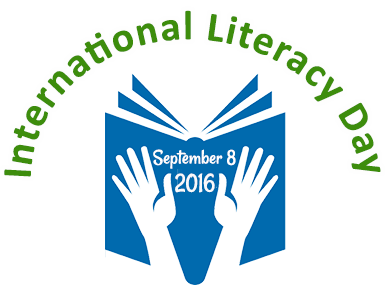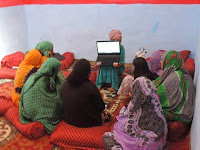Dar Si Hmad is pleased to welcome guest contributor Oumhani Benhima, an Environmental Youth Ambassador. Oumhani wrote a piece showcasing the importance of the ozone layer to celebrate today's International Day for the Preservation of the Ozone Layer. Oumhani's French version, published below, was translated into English by former Fulbright English Teaching Assistant and Dar Si Hmad Intern Zeke Caceres. Thanks to Oumhani and Zeke!
It is not by coincidence that the United Nations General Assembly has chosen September 16 for this day of action and raising awareness to the problems of the protection of the ozone layer. September 16 is the anniversary of the signing of the Montreal Protocol in 1987.
This year’s International Day for the Perseveration of the Ozone Layer is celebrated under the theme “Ozone Layer and Climate: Restored by a World United.”
Industrial gases used in refrigerators and aerosols (a type of chlorofluorocarbon or hydrochlorofluorocarbons) are responsible for the depletion of the ozone layer - an atmospheric 'blanket' necessary for life on Earth that allows for the filtration of ultraviolet rays. To protect the ozone layer, the international community has set targets for the progressive elimination of these chemical substances. Between 1988 and 2010, the international community has reduced the emission of chlorofluorocarbons (CFC) by more than 80% under the Montreal Protocol. These efforts have allowed us to see an improvement in the state of the ozone layer, especially around the Antarctica. According to scientists, the hole currently there could return to its pre-1980 state after 2050.
The protection of the ozone layer also is linked to climate change, as the gas that destroys it is a strong greenhouse gas. Consequently, the important fight that has been undertaken against gas destructive to the ozone layer is also a beneficial action for the climate.
To fight against climate change, the COP (Conference of Parties) was created and set in place to frame the efforts of the participating countries. In November 2016, COP 22 will take place in Marrakech, Morocco. This international reunion has already been announced as the “Conference of Action,” following the decisions taken by the previous edition of COP held in Paris.
One of the saddest realities of climate challenge is its unequal impact. Already marginalized groups bear the weight off the environmental degradation.
Acknowledging this fact, Dar Si Hmad has taken up the challenge of collecting potable fog water with its unique project in North Africa.
Some forty nets have been installed a an altitude of 1,225 meters at the peak of the Boutmezguida Mountain which overlooks five villages in the semi-arid region of Sidi Ifni. These nets capture droplets contained in the dense fog which surrounds the mountain. The drops are then treated, mixed with groundwater and transported via pipelines to the five villages below. This technique avoids a need for the inhabitants to journey several kilometers to get water.
In parallel with this project, Dar Si Hmad organizes the mobile Water School. The Water School was conceived with one main objective: to use the fog project as an entry to teaching through which children learn not only about water but also discover the natural world via scientific tools and see this world in a different way.
Dar Si Hmad, in partnership with the Regional Delegation of Education in Sidi Ifni, organizes activities and diverse courses in the rural schools of Aït Baamrane. The students learn to understand many aspects related to the theme of water, as well as the interdependence of ecosystems. The adopted approach aims to engage the students entirely: spirits, hearts and bodies.
Lastly, but certainly not least, the environmental program directed by ambitious youth, under the auspices of Dar Si Hmad, Environmental Youth Ambassadors (EYAs). Until now, the EYAs have contributed to the 2016 Water School, organized two community events with more than 60 young participants, and held events to raise awareness through visual narration and environmental journalism to advocate about environmental matters in southwest Morocco at a local and international scale that have not received attention or substantial publicity. Especially as the COP 22 Conference held in Marrakech in November 2016 approaches, this type of initiative will be a significant contribution to the dialogues and commitments of COP 22, showcasing the dynamic efforts of young Moroccans who raise awareness in the fight against climate change.
The protective ozone barrier makes live on our planet possible. It contributes in a large way to the fight against climate change. From the importance of this day of action and awareness which is an opportunity to exchange our experiences and results, let us take this opportunity to make people more conscious of this responsibility!
Simple daily acts can allow the reduction of greenhouse gas emissions. By consuming energy and our daily daily purchases, we directly or indirectly provoke the emission of greenhouse gases. Therefore, let us protect our planet!
Let’s buy more sustainable products!
Let’s reduce our electric consumption!
Let’s sort out our waste!
And let’s change our transportation habits!
Aujourd’hui nous célébrons la journée internationale de la protection de la couche d’Ozone. Dar Si Hmad, en collaboration avec ses Jeunes Ambassadeurs de l’environnement ont relevé le défi du changement climatique.
Ce n'est pas un hasard si l'assemblée générale des Nations Unies a choisi la date du 16 septembre pour cette journée d'action et de sensibilisation aux problèmes de la protection de la couche d'ozone(http://www.un.org/fr/events/ozoneday/). En effet, le 16 septembre est la journée anniversaire de la signature du Protocole de Montréal en 1987.
La Journée internationale pour la préservation de la couche d'ozone de cette année est célébrée sous le thème ‘’Couche d’ozone et climat : agissons tous ensemble pour les rétablir’’.
Les gaz industriels utilisés dans les réfrigérateurs ou les aérosols (de type chlorofluorocarbures, ou hydro chlorofluorocarbures) sont responsables de l’appauvrissement de la couche d’ozone, alors que celle-ci est indispensable à la vie sur terre et permet la filtration des rayons ultraviolets. Pour protéger la couche d’ozone, la communauté internationale s’est donné pour objectif l’élimination progressive de ces substances chimiques. Entre 1988 et 2010 elle a, grâce au protocole de Montréal, réduit les émissions de chlorofluorocarbures (CFC) de plus de 80 %. Ces efforts ont ainsi permis de constater l’amélioration de l’état de la couche d’ozone qui, selon les scientifiques, devrait retrouver ses propriétés d’avant 1980 d’ici à 2050 pour les latitudes moyennes.
La protection de la couche d’ozone a également un lien avec les changements climatiques, car les gaz qui la détruisent sont aussi de puissant gaz à effet de serre. Par conséquent, l’importante lutte qui a été menée contre les gaz destructeurs de la couche d’ozone a aussi été une action bénéfique pour le climat.
Pour lutter contre les changements climatiques, les COP (Conference Of Parties) ont été créés et mises en place pour encadrer les efforts des pays qui sont Parties à la Convention. En novembre 2016 se déroulera la COP 22 (http://www.cop22.ma/fr ) au Maroc, à Marrakech. Cette nouvelle réunion internationale est déjà annoncée comme la « Conférence de l’action », suite aux décisions prises lors de l’édition précédente de la COP qui s’est tenue à Paris.
L'une des réalités les plus tristes du changement climatique est son impact inégal. Des groupes déjà marginalisés supportent tout le poids de la dégradation de l'environnement.
Reconnaissant ce fait, l’association Dar Si Hmad a relevé le défi de collecter l’eau potable du brouillard avec son projet unique en Afrique du nord.
Une quarantaine de filets ont été installés à 1 225 mètres d'altitude, au sommet de la montagne Boutmezguida qui surplombe cinq villages de la région au climat semi-aride de Sidi Ifni. Ces filets récupèrent les gouttelettes contenues dans le dense brouillard qui enveloppe la montagne. Les gouttes sont ensuite traitées, mélangées à de l'eau de forage puis transportées via des canalisations aux cinq villages en contrebas. Cette technique évite aux habitants de parcourir chaque jour plusieurs kilomètres pour se ravitailler en eau.
En parallèle avec ce projet, Dar Si Hmad dirige une école de l'eau mobile. L'école de l'eau est conçue avec un objectif principal, celui d’utiliser le concept de l’école de l’eau comme moyen d’enseignement par lequel les enfants apprennent non seulement à propos de l’eau, mais aussi découvrent le monde naturel via des outils scientifiques et voient ce monde de manière différente.
Dar Si Hmad, en partenariat avec la Délégation régionale de l’enseignement à Ifni, organise des activités et divers cours dans les écoles rurales de Aït Ba Amrane. Les élèves apprennent à comprendre tous les aspects liés au thème de l’eau , ainsi que l’interdépendance des écosystèmes. La démarche adoptée vise à engager les enfants à part entière, esprits, cœurs et corps.
Dernier point, mais non des moindres, le programme environnemental dirigé par des jeunes ambitieux sous l’encadrement de l’association Dar Si Hmad; Jeunes Ambassadeurs de l’Environnement (EYA) qui, jusqu’à présent, ont contribué à l’école de l’eau 2016, organisé deux évènements communautaires avec plus de 60 jeunes participants, et mènent des activités de sensibilisation à travers la narration visuelle et le journalisme environnemental pour plaider en faveur des questions environnementales au sud-ouest du Maroc à l'échelle locale et internationale qui n'a pas reçu une attention ou une publicité importante. D'autant plus que la conférence COP22 qui se tiendra à Marrakech en Novembre 2016 approche ,ce genre d’initiative sera une contribution importante aux dialogues et aux engagements de la COP22, mettant en vedette les efforts dynamiques des jeunes marocains qui élèvent la sensibilisation et la lutte contre le changement climatique.
Cette barrière protectrice rend possible la vie sur notre planète. Elle contribue aussi de manière significative à la lutte contre le changement climatique. D’où l’importance de cette journée d’action et de sensibilisation qui est une occasion pour échanger nos expériences et nos résultats, saisissons cette opportunité pour rendre les gens plus conscients de cette responsabilité !
De simples petits gestes quotidiens peuvent permettre de réduire les émissions de gaz à effet de serre. En consommant de l'énergie et par nos achats quotidiens, nous provoquons directement ou indirectement des émissions de gaz à effet de serre. Alors, préservons notre planète !
Achetons des produits plus respectueux !
Réduisons notre consommation électrique !
Trions nos déchets !
Et changeons nos habitudes de transport !








